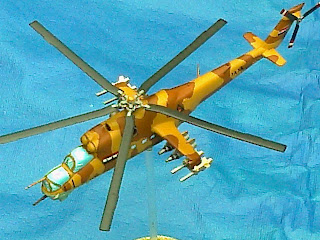This collection was mainly built during the 90ies when Desert Storm was still echoing. But this conflict -as the Falklands, as Lebanon 82- is part of my memories and that urges me to constantly add new stuff. Many camouflages and paint schemes are conjectural, others based on photos and some on published artistic sideviews. All aircraft have pegs to be able to "fly" as wargame pieces.
The above plane is Mig-21 Fishbed from Fujimi, probably the best Mig-21 kit at least on those days.
The acompanying Mig-21 of the Fujimi´s are (right) Academy Mig-21 with the humpback made out of GreenStuff to make it a more recent Mig-21 model and (left) a Matchbox one.
Mig-23 ML from Hasegawa.
This Mig-23 has shaff dispersers on its tail made out of Evergreen with small drilled holes.
Another Mig-23 from Hasegawa with the white radome (MS variant), signalling a less powerful radar.
The Mig-23 pack.
The Mig-27 (or Mig-23 BN) ground attack aircraft from Academy armed with bombs.
Another one armed with missiles.
The Mig-27 pack.
The third one has a Mirage F-1 refuelling device, an Iraqi way to make air-refuelling possible from the Il-76 (I need one of those...).
The last of the Mig-27. This one is separated from the others due to its style of painting (or lack of it...).
Airfix Mig-29 Fulcrum. The Iraqi Fulcrums had several air aces in their ranks, including colonel Jameel Sayhood who shot down aircraft both in the Iran-Iraq war and Gulf war. He was downed during the war against F-15 Eagles but parachuted himself and it is not known if he survived.
Not sure, but clockwise: 12.00- diecast ; 01.00-Airfix, 06.00-Esci and 11.00 Italeri.
Su-24 Fencer by Italeri.
Su-24 load.
Su-22 Fitter. This camouflage, darker than usual, was inspired on some photos of Fitters that look for sanctuary in Iran during Desert Shield, when Saddam Hussein looked for his eastern neighbour- (former hatred foe) as a last chance for finding friends. These airplanes never returned to Iraq.
Su-25 Frogfoot, Academy.
Su-25 Frogfeet (?) pack, with different weapon loads.
Su-7 (Smer or KP, not sure). For me the nicest camouflage on any Iraqi aircraft.
Su-7/20 pack.
The most beautiful aircraft on the Iraqi arsenal, for me at least, the Mig-25 foxbat was one of the few Iraqi airplanes who was able to shoot american aircraft during Desert Shield/Storm. The other ones were Mig-23 and Mig-29 who accounted for 5 allied kills and 4 damaged aircraft (including kills of F-18 Hornet, F-111, Tornado and B-52). Initially the allies denied loosing any aircraft to Iraqi fighters but recently admitted these losses... The Iraqi had a total of 23 losses in air combat.
Mig-25 pack, kits from Hasegawa. One Mig-25 PDS killed the fist american aircraft of the war, a F/A-18 Hornet. The remains of the pilot, USN Capt "Scott" Spetcher, were found in 2009 in the desert after his burial by beduin tribesmen in 1991, immediately after crashing to his death.
If Iraqi airforce had received the Mig-31, maybe they looked like this one...
Mirage F-1 from Esci.
The Exocet missile carried by the Mirage F-1. This colour scheme is not probably the one available for the Iraqi but the only one I had info at the time of painting.
Mil-Mi 24 Hind by Airfix.
Same as above (Esci), with diferent colour scheme.
Pack of Hinds.
MBB BO 105, Airfix kit with scratchbuilt TOW missiles.
Oldies: Il-28 Beagle by Airfix.
Hawker Hunter by Airfix.
Mig-19 Farmer by KP.
Mig-21( or Shenyang F-7) by Academy.
Mig-23 by Airfix, parked to serve as a possible wargame scenario piece.
Tu-22 Blinder by Esci: the largest of the Iraqi warplanes. It measures 50 cm and dwarfs the Fujimi Mig-21 by its side. Its camouflage, if done today, would be green and grey as portrayed in the Middle East Database website.
In order to enhance the pannel gravings I use a simple sharpened charcoal pencil.

















































